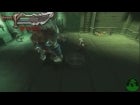Earlier today at GDC, we managed to get a front seat for the breakdown of all of God of War: Chains of Olympus' nitty-gritty little details. The meaty keynote, entitled "God of War: Deconstructing an Epic," was presented by Ready At Dawn's Nathan Phail-Liff, the lead 3D artist on the upcoming PSP title.
Phail-Liff said he aimed to give as detailed of a dissection as could be offered in an hour. "When I was coming up with a name for this panel, I tried out a few titles, like 'Dissecting an Epic,' or 'Downfall of a Franchise,'" he said, jokingly. He was a bit less facetious when it came to the game itself: "At Ready At Dawn, we have a 'no BS policy,' and I'm here to tell you all: nothing came easy during this project. The difference between a Triple-A game and an average game is mostly about how you and the team react to mistakes made, and how you pull it together in spite of yourselves."
The lecture was broken down into three topics: how the team visually defined the term "epic," the mistakes made during the process, and how the team managed to overcome those mistakes and find ways to quickly and efficiently create new iterations. By the end of the presentation, it was evident why gamers haven't seen much of the game until recently: Ready At Dawn was grinding away at and tweaking it so much. Phail-Liff pointed out that none of the ideas that the Ready At Dawn team implemented were exclusive to the PSP, and that most of these ideas could be carried out on any platform.
Who'd Have Thought Fog Was a Good Thing?
The first section, which Phail-Liff referred to as "Epicidal," touched on how the team wanted to keep the player immersed in such a large-scale world, and how it did so. CoO uses the environments as a means of developing characters. The regions, he explained, are as crucial as Kratos himself, and a jarring transition pulls people out of the experience. He presented this challenge as two questions: "Where did I come from?" and "Where am I going?" CoO's level design trickles in gradual environmental changes. Specifically, Phail-Liff said, Kratos goes from a dry, arid desert area into a wet underground cave. As the current locale transitions in the game, gamers will see trickles of progress, such as grass and tiny pools of water that slowly blend into a new section of the stage.
Beyond this subtle difference, Phail-Liff pointed out that within this visual framework gamers are more likely to suspend disbelief, but in order to make things seem epic, it's up to developers to carefully create a sense of scale. Rather than waste geometry and resources on making huge objects that gamers won't appreciate, it's better to use smaller shapes in the background to create a more grandiose sense of scale, he said. He presented a video of the Battle of Attica level, and how ships in the foreground of Kratos' battle are significantly bigger, but that smaller scale (yet detailed) objects in the background truly sell the epic nature of the stage.
From there, Phail-Liff described what he referred to as the "Fog of War." In the same video, he showed off how texturing, shading, and resolution all go a long way in creating the massive scale that the Ready At Dawn team aimed to incept. Through the use of fog, the CoO team could give the game a convincing atmospheric depth. Because fog and clouds are something of a visual distraction, it made for a handy tool to fuse two-dimensional elements with three-dimensional assets to toy with gamers' visual perception. Phail-Liff showed off the Attica level before fog implementation and after, and the difference was profound. The atmospheric depth was even more evident in underwater levels. Without fog, Kratos' dives resembled someone swimming in zero gravity. However, with a trickling of mist and proper lighting, the viscosity of the water became more evident.





